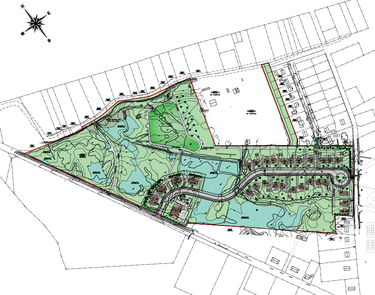Lack of changes to Black Creek Run proposal irks some town board members
GUILDERLAND — The three Guilderland council members who were on the town board in 2023 when Rosetti Properties, the developer for Black Creek Run, last presented plans — Jacob Crawford, Amanda Beedle, and Christine Napierrski — were critical on June 17 that more changes hadn’t been made.
After 50 minutes of questioning the developer’s agents and the town’s engineer, the board scheduled a public hearing on the proposal for Aug. 19 at 7 p.m. at Guilderland Town Hall.
The last hearing on the proposal, in November 2023, lasted two hours. All of the citizens who spoke, many of them neighbors of the proposal, were against it.
Black Creek Run is proposed to be a 46-unit Country Hamlet on 34.8 acres in a Rural Agricultural District across School Road from the high school in Guilderland Center. It is to be developed with eight twin townhouses, 24 single-family homes, and 14 senior apartments.
About 60 percent of the land is to be conveyed to the town of Guilderland; much of it is unbuildable wetlands.
An earlier version of the project called Dutchmen Acres — the development is across School Road from Guilderland High School, which has the Flying Dutchman as a mascot — lay dormant from 2009 to 2015 when the current configuration was presented to the town’s planning board.
As early as 2009, the town board raised concerns that site runoff into the Black Creek would be contaminated. The Black Creek feeds into the Watervliet Reservoir, Guilderland’s major source of drinking water.
Rosetti, which acquired the land at 6250 Depot Road in 2014 for $306,000, proposed Country Hamlet zoning to allow far more housing units, in a clustered formation, than the Rural Agriculture 3 zoning. The Guilderland Town Board is lead agency for all Country Hamlet project applications.
Matthew Falvey, vice president of development for Rosetti, started his update presentation on June 17 by telling the board “we’ve done our best” to address neighbors’ concerns.
The proposed stormwater basin, which had been planned to be adjacent to Heidi and Michael Moak’s farm on Cerruti Road, has been “pushed as far away” as possible, Falvey said.
Rosetti has agreed to make a $75,000 contribution to fund a project that would deal with wastewater issues in nearby neighborhoods, he said.
Rosetti has also agreed to contribute about $50,000 “to improve sidewalks and pedestrian connectivity at the intersections of Depot, School Road, and Meadowdale Road,” he added.
Falvey stressed the “nice variety of housing stock” with apartments for seniors, duplexes, and single-family homes.
“We’re confident that, with the proximity to school, that we will be able to hopefully put teachers and staff members in these homes and apartments,” said Falvey.
Water concerns
“So what is the difference between the presentation you’ve made to us previously versus the wetland delineations you’ve shown here on this map?” asked Crawford.
Crawford went back and forth with Nicholas Costa, owner of Advanced Engineering & Surveying, more than half-a-dozen times, trying to get an answer to that question.
Crawford reiterated concerns neighbors had raised “about where the water was going to go once it accumulated on this property” to which Costa responded the plan was in accordance with the stormwater design manual put out by the state’s Department of Environmental Conservation.
“What have you done to address these concerns?” Crawford asked again.
“I’m not aware of those concerns,” responded Costa, reiterating that state regulations are being followed.
“You got grilled by this board over the concerns …. Not to have any amendments to the prior project, it’s kind of mind-boggling,” said Beedle.
Falvey intervened to say that, because of concerns raised earlier, the plan now is to build the homes at Black Creek Run without basements.
Beedle raised concerns about teenagers from the school coming to harm if they accessed the retention pond. The pond will be fenced around its perimeter, Falvey responded.
“Many residents came and expressed their concerns about flooding in their basements and on their property,” said Deputy Supervisor Christine Napierski. She referenced the excessive rain this past spring and asked if the planned retention pond “would be adequate to drain the excess runoff from a season like the one we’ve just had?”
“Yes, this is a 100-year pond, so 100-year-storm pond,” Falvey responded.
Napierski then asked if the stormwater pond would benefit the neighboring properties.
Jesse Fraine, the town’s engineer, explained that the DEC required an analysis “accounting for the type of soils, the existing site, how much runoff comes off the site, and then looking at the developed site, doing those calculations based on the same parameters.”
Additional swales would be put in, Fraine said, to direct water from neighboring properties to the pond.
“Right now, due to the soils there,” Fraine said, there’s a lot of wetland, low-infiltration soils. So water sits …. Directing that stormwater to areas that can handle that flow could be beneficial to neighbors.”
Beedle asked about the developer clearing out trees, which currently absorb water, to which Fraine replied, “The design is taking account for that change in vegetation.”
Napierski asked about making several smaller ponds instead of a larger one.
“It actually is two small ponds right next to each other,” said Fraine, explaining that, according to DEC guidance, one pond allows sediment to settle.
“It flows over into the final treatment pond which has the vegetative aquatic bends …,” he said, “which helps treat that stormwater.”
Fraine also said that stormwater from the area discharges into a town-owned treatment plant at the Northeastern Industrial Park. “We see a large flow at the plant where we are at the upper limits of the plant’s capabilities,” said Fraine.
It would take about $100,000, Fraine said, to line the existing sewer pipes so they don’t get infiltrated with groundwater, thereby reducing the overall flow the plant handles. The $75,000 from Rosetti would go towards lining the pipes, he said.
“You’re just really, really trying to keep the stormwater out of the sewer,” summarized Supervisor Peter Barber.
Fraine agreed, “We’re just trying to keep [out] stormwater, groundwater, any water except for wastewater.”
Beedle expressed concerns, with “creeks around here just massively overflowing,” that the planned two-acre retention pond would be inadequate.
The pond is designed with “a number of outlets,” Frame said, explaining, “the whole idea is to mitigate the direct impact to the Black Creek or to the downstream drainage area in general.”
Napierski said, “I just want some type of assurance, in plain language, that this is not going to harm the Moak property or the other properties in the neighborhood” or cause more flooding from the Black Creek.
“What we have in place does help him directly,” Favey said of Moak. “And it helps the other neighbors."
Traffic concerns
In 2023, neighbors of the project, in addition to raising concerns about increasing water problems in an area already prone to flooding, also raised concerns about increasing traffic in an area already suffering from delays.
Falvey told the board on June 17 that, during construction, trucks would be limited to certain times of the day to avoid “impacts from the school and buses and kids and staff getting to the school.”
The schedule would be worked out, he said, at a preconstruction meeting with the general contractor, the developer, the builder, and the town staff.
Councilman Gustavo Santos surmised that, with the preconstruction meeting guidelines, it shouldn’t be a problem.
“I disagree,” said Crawford. Despite guidelines arranged at a preconstruction meeting he said, “When the cement delivery is ready, the cement delivery is coming.”
He went on, “My issue is that now falls on the staff and the town zoning and building office to enforce.”
Beedle raised concerns about the overall traffic problems in the area, not just during the construction period.
She described a difficult “triangle of traffic” between Route 146, Depot Road, and School Road.
Beedle recalled being told, in 2023, that people could just leave 15 minutes earlier. “That was not an acceptable option for people that are already here,” said Beedle, adding, “I do remember, right, some of these households were going to be upwards of $500,000, was that not correct?”
“I don’t have specific figures,” said Falvey, conceding, “That’s a ballpark.”
“I don’t know that’s family-starter home size,” said Beedle, “but, still, the concern is the output of traffic in a very problematic area to begin with.”
Beedle went on to ask if an updated traffic study had been done. In 2023, she called the study, which had been conducted during the COVID-19 pandemic “baloney.”
Ken Worsted, with Creighton Manning Engineering, responded, “No, we haven’t done anything since.” The study had been conducted in 2021, he said, adding of the effects of the pandemic, “We were still kind of living with that influence.”
Worsted went on, “We had looked back to 2019 and said, ‘What are the volumes out there before all of this was going on’ because at the time, too, we didn’t know where we were going.”
While people were forced to work from home during the pandemic shutdown, he said, “People are still going to do that.”
So adjustments were made, based on traffic numbers from 2019, before the pandemic. “The afternoon peak hour was about 40 percent lower than what it should be,” Worsted said, “so we made those adjustments to that. The a.m. peak hour was 70 percent lower than it should be so we made adjustments to that.”
He then distributed to the board a packet tallying traffic-count station reports with graphs.
“The volumes over the past decade,” Worsted said, “have remained fairly flat or have decreased by a slight amount … We’re outside the pandemic direct impact and now were kind of living in this new normal,” Worsted concluded.



